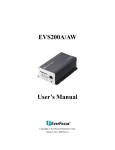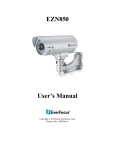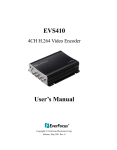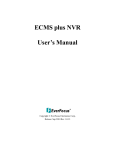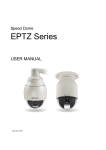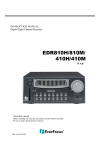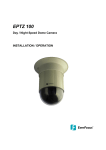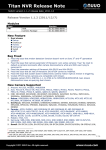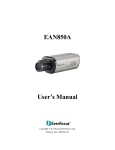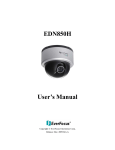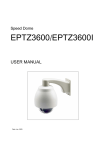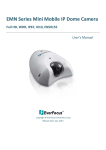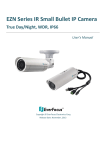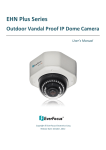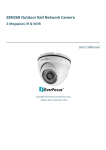Download EverFocus EPN 3600
Transcript
EPN3600 IP PTZ Speed Dome User’s Manual Copyright © EverFocus Electronics Corp, Release: July 2009 EPN3600 Product Name: EPN Series EverFocus Network Speed Dome FCC Notice "Declaration of Conformity Information" This equipment has been tested and found to comply with the limits for a Class A digital device, pursuant to part 15 of the FCC Rules. These limits are designed to provide reasonable protection against harmful interference in a residential Installation. This equipment generates, uses and can radiate radio frequency energy and, if not installed and used in accordance with the instructions, may cause harmful interference to radio communications. However, there is no guarantee that interference will not occur in a particular installation. If this equipment does cause harmful interference to radio or television reception, which can be determined by turning the equipment off and on, the user is encouraged to try to correct the interference by one or more of the following measures: - Reorient or relocate the receiving antenna. - Increase the separation between the equipment and receiver. - Connect the equipment into an outlet on a circuit different from that to which the receiver is connected. - Consult the dealer or an experienced radio/TV technician for help. Warning: Changes or modifications made to this equipment, not expressly approved by EverFocus or parties authorized by EverFocus could void the user's authority to operate the equipment. This device complies with part 15 of the FCC Rules. Operation is subject to the following two conditions: (1) This device may not cause harmful interference, and (2) This device must accept any interference received, including interference that may cause undesired operation. EverFocus Electronics Corp. 12F, No. 79, Sec. 1, Shin-Tai Wu Rd., His-Chi, Taipei Hsien, Taiwan, R.O.C. EPN2700/3100/3600 complies with CE and FCC. 2 EPN3600 About this document All the safety and operating instructions should be read and followed before the unit is operated. This manual should be retained for future reference. The information in this manual was current when published. The manufacturer reserves the right to revise and improve its products. All specifications are therefore subject to change without notice. Safety Notice -These limits are designed to provide reasonable protection. This equipment generates, uses and can radiated radio frequency energy and, if not installed and used in accordance with the instructions, may cause harmful interference to radio communications. However, there is no guarantee that interference will not occur in a particular installation. If this equipment does cause harmful interference to radio or television reception, which can be determined by turning the equipment off and on, the user is encouraged to try to correct the interference by one or more of the following measures: -Reorient or relocate the receiving antenna. -Increase these separations between the equipment and receiver. -Connect the equipment into an outlet on a circuit different from that to which the receiver is connected. -Consult the dealer or an experienced radio/TV technician for help. The changes or modifications not expressly approved by the party responsible for compliance could void the user's authority to operate the equipment. To reduce risk of fire or electric shock, do not expose this appliance to rain or moisture. Do not attempt to disassemble the appliance. To prevent electric shock, do not remove screws or covers. There are no user-serviceable parts inside. Contact qualified service personnel for maintenance. Handle the appliance with care. Do not strike or shake, as this may damage the appliance. Do not use strong or abrasive detergents when cleaning the appliance 3 EPN3600 body. Use a dry cloth to clean the appliance when it is dirty. When the dirt is hard to remove, use a mild detergent and wipe gently. Do not operate the appliance beyond its specified temperature, humidity or power source ratings. Do not use the appliance in an extreme environment where high temperature or high humidity exists. Use the appliance at temperature within 0℃ ~ +40℃ / 32 ~ 104 and a humidity below 90%. The input power source for this appliance is 12 VDC & PoE. Use only the recommended power supplies. Power supplies must comply with the requirement of the latest version of IEC60950-1. Substitutions may damage the unit or cause a fire or shock hazard. Electrostatic-sensitive device. Use proper CMOS/MOSFET handing precautions to avoid electrostatic discharge. Installation should be performed by qualified service personnel only in accordance with the National Electrical Code or applicable local codes. Terms and Trademark Ethernet, Internet Explorer, Linux, Microsoft, Windows, WWW are registered trademarks of the respective holders. Other product names appearing in this User's Guide may be trademarks or registered trademarks of their respective holders. Java™ and all Java-related logos and trademarks are trademarks or registered trademarks of Sun Microsystems, Inc. in the United States and other countries. Support If the unit ever needs repair service, the customer should contact the nearest EverFocus Electronics Corp. Service Center for return authorization and shipping instruction. 4 EPN3600 TABLE OF CONTENTS 1. INTRODUCTION.................................................................................................7 1.1. FEATURE .....................................................................................................7 1.2 ACCESSING THE CAMERA MENU ..............................................................9 2. SETTING ............................................................................................................16 2.1 SYSTEM INFO...........................................................................................16 2.1.1 Information..........................................................................................16 2.1.2 Log.......................................................................................................17 2.2 USER CONFIG ..........................................................................................18 2.3 NETWORK .................................................................................................20 2.3.1 Network...............................................................................................21 2.3.2 DDNS ..................................................................................................23 2.3.3 Bandwidth...........................................................................................24 2.3.4 SMTP/FTP..........................................................................................25 2.3.5 Network Alarm (reserved for PowerCon).......................................27 2.4 VIDEO .........................................................................................................27 2.4.1 Multi Streaming ..................................................................................28 2.4.2 Camera ...............................................................................................29 2.4.2.1 POSITION SETTINGS .............................................................30 2.4.2.1.1 Set Preset...................................................................................30 2.4.2.2 2.4.2.2.1 2.4.2.2.2 2.4.2.2.3 AUTO MODE SETTINGS ........................................................31 Set Auto Tracking ......................................................................31 Set Auto Pan ..............................................................................42 Set Tour.......................................................................................44 2.4.2.2.4 Set Pattern .................................................................................45 2.4.2.3 PTZ OSD SETTINGS ...............................................................47 2.4.2.3.1 VIDEO SETTINGS ....................................................................49 2.4.2.3.1.1 Exposure..................................................................................49 2.4.2.3.1.2 2.4.2.3.1.3 2.4.2.3.1.4 2.4.2.3.1.5 Focus Mode.............................................................................51 Digital Zoom ............................................................................52 White Balance.........................................................................52 Backlight ..................................................................................53 2.4.2.3.1.6 2.4.2.3.1.7 2.4.2.3.1.8 2.4.2.3.1.9 Day/Night .................................................................................53 Color .........................................................................................55 Negative...................................................................................55 Wide Dynamic Range ............................................................56 5 EPN3600 2.4.2.3.2 OSD/AREAS ..............................................................................56 2.4.2.3.2.1 Areas ........................................................................................57 2.4.2.3.2.2 Directions.................................................................................59 2.4.2.3.2.3 Display .....................................................................................60 2.4.2.3.3 PRIVATE ZONES ......................................................................63 2.4.2.3.4 INFO ............................................................................................65 2.4.2.3.5 EXIT.............................................................................................66 2.5 AUDIO.........................................................................................................66 2.6 USER ..........................................................................................................68 2.7 EVENT ........................................................................................................69 2.7.1 Event ...................................................................................................70 2.7.2 Motion..................................................................................................74 2.7.3 Alarm ...................................................................................................75 2.7.4 Time Mask ..........................................................................................76 2.8 SYSTEM .....................................................................................................77 2.8.1 Date/Time ...........................................................................................77 2.8.2 Daylight Saving..................................................................................79 2.8.3 Maintenance.......................................................................................80 2.9 EKB200.......................................................................................................82 3. SPECIFICATIONS ............................................................................................85 6 EPN3600 1. INTRODUCTION The innovative EPN Series from EverFocus is a high performance multi stream H.264 IP speed dome featuring intelligent auto tracking functions. EPN is built-in H.264/MPEG-4/MJPEG digital signal output at 4CIF image size with up to 30fps and H.264/MPEG-4/MJPEG multi stream output for simultaneous live monitoring and high resolution recording. EPN also supports smart auto tracking functions such as exclusive masking, pan/tilt limits, tracking on patrol and flexible resume functions. EPN is designed for simple installation and supports all types of outdoor/indoor mounting applications. 1.1. FEATURE z Support smart auto tracking functions z Built-in H.264/MPEG-4/MJPEG digital signal output at 4CIF image size with up to 30fps H.264/MPEG-4/MJPEG multi stream output for simultaneous live monitoring and high resolution recording z z z z z z Support 3 independent video streams that can provide different compression formats and resolutions Support MDI/MDI-X auto crossover function Bandwidth control: 64K/128K/256K/1M/2M/4M/8M bps and unlimited Built-in network interface (10Base-T/100Base-TX) for remote monitoring by PC Smart Wizard settings for various event and schedule recording conditions z z z z One-click easy installation Built-in 27X/30X/36X optical AF zoom camera True Day/Night function with removable IR cut filter Low luminance for better image quality at night z Wide Dynamic Range (WDR) z z z Digital Slow Shutter (DSS) Built-in Dynamic Noise Reduction (DNR)* Digital Image Stabilizer (DIS)* z z Motion Detection Privacy Zone Masking* 7 EPN3600 z z z Excellent position accuracy to ±0.1 degree From super low [0.01°/sec] to high fast [360°/sec] pan/tilt speed IP66 rated housing for any-weather outdoor use z z z Maximum 192 preset positions available Support directional virtual compass for easy operation. Users can select any reference direction as North Point. Programmable auto pan / 16 tours / 4 patterns z z z z 4 priority alarm inputs & 2 alarm outputs Smart alarm reaction & resume after alarm Enhanced auto-resume & power-up function Digital Flip function *Features and specifications vary on different models. Please see the spec sheets for the detail. 8 EPN3600 1.2 ACCESSING THE CAMERA MENU Step 1.Start an Internet Explorer browser. Step 2. Enter the IP address or host name of the camera in the Location/Address field of your Internet Explorer browser. (Please refer to EPN2700/3100/3600 Installation Guide for how to find the IP address) Step 3. Input “Username” and “Password”. Default Username is “user1” and default password is “11111111”. Step 4. Click “Login” button. Step 5. You might be required to download Active X, which is required to view camera video. Please click "Yes". Step 6. Congratulation!! You should be able to see the live image now (See sample image: Figure 1-1 ). 1○8 1○9 ○1 ○2 ○3 ○4 ○5 ○6 ○7 ○8 ○9 1○1 1○3 1○0 1○2 1○4 1○5 1○6 1○7 Figure 1-1 Default page of Camera Menu ○1 Press button to enter Nevio Express system. For more details, please refer to Nevio Express user manual. For multi-channels recording, it is suggested to use Nevio Express. 9 EPN3600 ○2 Press button to display the "Live" page. Double click on the image to show a full screen display, double click again or press ESC to return normal display. ○3 Press button to enter Setting page. In Setting page, there are 8 sections: [System Info], [User Config], [Network], [Video], [Audio], [User], [Event] and [System]. Please refer to “2 SETTING” for further information. ○4 Press button to close EPN2700/3100/3600 network page. ○5 Video Stream Select Video Stream from Stream 1 / Stream 2 and Stream 3. Please refer to “2.4.1 Multi Streaming” for further information. ○6 View Size You can select View size to either reduce or enlarge the image to the appropriate view size. Select the view size for live images from: NTSC: 4CIF (704*480) / VGA (640*480) / CIF (352*240) / QVGA (320*240) / QCIF (176*120) PAL: 4CIF (704*576) / VGA (640*480) / CIF (352*288) / QVGA (320*240) / QCIF (176*144) ○7 Record The record button is used to record the current video stream. The location 10 EPN3600 where the image file is saved can be specified in “Setting -> User’s Config”. Please refer to “2.2 USER CONFIG” for further information. Note: Record segment is limited to 1 min. If you need to do long time recording, please set schedule recording. For schedule recording info, please see “2.7 EVENT”. ○8 Snapshot Click Snapshot button to save a snapshot of the video image currently being displayed. The location where the snapshot data is saved can be specified in “Setting -> User’s Config”. Please refer to “2.2 USER CONFIG” for further information. ○9 ~ 1○0 Play Audio/Transmit Audio Click the “Play Audio” and “Transmit Audio” buttons to switch the sound off and on for the speaker and microphone, respectively. 1○1 PTZ Control – / Click “Open” button to open PTZ control window. (See red maker in Figure 1-2 ) Click “Close” button to hide PTZ control window. 11 EPN3600 Figure 1-2 PTZ Control Window : Zoom in : Zoom out : Focus far Focus near : Iris + : Iris – Arrow buttons: Click on an arrow button to navigate in that direction. : stop current action. : User can select PTZ speed from High, Standard, Low and Minimum. 12 EPN3600 Preset button: Click this button first, and input a preset position number by clicking number key and then click “Go” button to move the camera to a preset location. Note: To use this function, user need to set preset location in advance. Please refer to 2.4.2.1.1 Set Preset” for setting details. Auto Pan button: Click this button first and input a preset auto pan No. by clicking number key (1 for AB Pan, 2 for Endless Pan) and then click “Go” button to run a preset auto pan. Note: To use this function, user need to set Auto Pan in advance. Please refer to”2.4.2.2.2 Set Auto Pan” for setting details. Pattern button: Click this button first and input a preset pattern No. by clicking number key (1 ~4) and then click “Go” button to run a preset Pattern. Note: 1. Click on live screen once to stop running pattern. 2. To use this function, user need to set Pattern in advance. Please refer to ”2.4.2.2.4 Set Pattern” for setting details. Tour button: Click this button first and input a preset Tour No. by clicking number key and then click “Go” button to run a preset tour. Note: To use this function, user need to set tour in advance. Please refer to”2.4.2.2.3 Set Tour” for setting details. A. Pan(T) button: Click this button first and input a preset auto pan No. by clicking number key (1 for AB Pan, 2 for Endless Pan) and then click “Go” button to run a preset auto pan with auto-tracking function ON. Tour(T) button: Click this button first and input a preset Tour No. by clicking number key (1 ~4) and then click “Go” 13 EPN3600 button to run a preset tour with auto-tracking function ON. Number button, Go button and Clear button: - Click desire number button and it will show in the gray text area at left-down corner. - Click “Clear” button to clear the text area. - Click “Go” button to run a selected function. 1○2 PTZ Control – Navigation Mode Select this to browse in direction user pointing at. 1○3 PTZ Control – Click-n-Go Mode Select this and system will center the pointing location for browsing. 1○4 / Auto Tracking –ON/OFF Click on/ off to enable/disable Auto Tracking function. 1○5 Select Object- Click this button and select an object on screen for auto-tracking. At this time, a icon will display on screen. Use arrow keys to select an object and press again to save this selection. 1○6 Event Manual Control – Trigger Press “Trigger Event” button to trigger an event directly from live view page, and event actions will be effective if they have been set in “Event” menu. (Please refer to “2.7.1 Event”) 14 EPN3600 1○7 Alarm Manual Control – Reset Press “Reset Alarm” button to reset alarm output remotely. 1○8 Status Display Show the name of the camera whose settings currently being configured, current date/time and current frame rate. 1○9 Event signals Tracking Alarm Motion When an alarm or motion event is triggered, a signal icon will flash to alert user. The first icon is for alarm event and rest of the 5 icons are for motion event. The motion event icons which differed by colors correspond to the motion trigger areas you have set in Motion menu. Please refer to “2.7.2 Motion” for detailed information about Motion setup. 15 EPN3600 2. SETTING Click Setting button (see red marker in Figure 2-1) to enter the setting menu (see Figure 2-2). There are 9 sections in setup menu: [System Info], [User Config], [Network], [Video], [Audio], [User], [Event], [System] and [EKB200]. Figure 2-1 Camera Menu- Setting 2.1 SYSTEM INFO System information and system log check of the setup menu can be performed on this page. The “System Info” page has 2 tabs: [Information] tab and the [Log] tab. See Figure 2-2. 2.1.1 Information System Information: Firmware version, MAC address, Video Type, Model number. (Unchangeable, for reference only) 16 EPN3600 Figure 2-2 System Info - Information 2.1.2 Log Figure 2-3 System Info -Log System Log: Date/Time: display date and time of the log. Log message: contain all information and event message, including login, 17 EPN3600 user’s IP, reboot, firmware upgrade, load factory default, configuration reset and event detected. System will keep the newest 256 records. Click button to export system log into a “.txt” file and select the location where the exported log file will be saved to. 2.2 USER CONFIG Figure 2-4 User Config User can set configuration of live view here. Each login user can make his/her own settings for the following items: Text Setting Check boxes of Machine name, Date/Time or Frame Rate to display these info on the screen. Foreground Color: change the Foreground Color of info text by moving the slide bar between Red, Green and Blue until your desire color is obtained. 18 EPN3600 Position: Select the position where the text will be displayed from Upper Left / Lower Right / Lower Left. Click Apply to apply the setting changes or Reset to reset without saving the change. Date/Time Format Used in Text Select Date/Time Format from the following options: Time Format: 24 Hours or 12 Hours. Click Apply to apply the setting changes or Reset to reset without saving the change. Recording/Snapshot Export Setting Enable Event Recording to PC: Allow event video recording to users' PC if any events have been set to trigger recording to PC. Export folder: Select Export folder by clicking on button, then direct to desired export folder. File size: User can limit the size of the single recording file in minutes here. When the single recording file size exceeds the time you set, the system will create a new file to continue recording. Overwrite: Select “ON” for overwriting recording/snapshot file when the disk storage capacity is full. Enter overwriting. User can set storage capacity limitation in the textbox in the following sentence. “If the remaining hard disk capacity is less than ____ MB (enter the value you wish to set between 50~2000), system will stop recording or start overwriting. “ Click Apply to apply the setting changes or Reset to reset without saving 19 EPN3600 the change. Language Setting Language: Select the language to be displayed in web page. Default language is English. To add a new language not listed in the original configuration, click the Browse button to locate the new language file (.evb) and then click the Load button. Note: Upload a new language file will cause system reboot automatically. Please reconnect IP speed dome after reboot. Click Apply to apply the setting changes or Reset to reset without saving the change. 2.3 NETWORK The network related settings, including Network, DDNS, Bandwidth, SMTP/FTP and Network Alarm can be configured on this page. There are 5 tabs in this field: [Network] tab, the [DDNS] tab, the [bandwidth] tab, the [SMTP/FTP] tab and the [Network alarm] tab. 20 EPN3600 2.3.1 Network Figure 2-5 Network Setting- Network The following information is required to configure the network settings. Contact your network administrator or your internet service provider to get the info. • IP Type • IP address • Subnet mask • Gateway (when using the gateway server/router) • Primary DNS, Secondary DNS (when using DNS) IP Type DHCP: do not assign DHCP server the same IP addresses used for the other network cameras and PCs whose IP address is unique. Refer to the network administrator for these settings of the server. Default: DHCP. Static IP: User can manually set the static IP for network connection. PPPoE: This is a DSL connection application and ISP will ask user to input user name and password. 21 EPN3600 Note: If PPPoE is used as IP type, IP Utility software will not be able to detect the device. IP address When DHCP is not used, user needs to manually enter the IP address of the camera. Do not enter the IP address already used for PC or other network cameras. Subnet Mask This field is used to set the netmask for your network so that the IP speed dome will be recognized within the network. Example: 255.255.255.000. When DHCP is selected, the DHCP server will assign this value automatically. Gateway This field is used to set the gateway for your network so that the IP speed dome will be recognized within the network. When DHCP is selected, the DHCP server will assign this value automatically. Primary DNS Enter IP address of DNS server that is provided by ISP. Secondary DNS If your ISP provides you an IP address secondary DNS, please set it here. Username Enter User name of the account (used only for PPPoE). Password Enter Password of the account (used only for PPPoE). Click Apply to apply the setting changes or Reset to reset without saving the change. 22 EPN3600 2.3.2 DDNS Figure 2-6 Network - DDNS DDNS setting When accessing the camera via the Internet from the network environment of which the global IP address is obtained using DHCP, the DDNS function is necessary. To use the DDNS function, it is necessary to connect to the dedicated DDNS server. We offer 4 DDNS server providers as follow: ○ www.everfocusddns.com ○ www.sitelutions.com ○ www.dyndns.com ○ www.no-ip.com Enable: Check the box to enable DDNS setting. Service ISP: If you choose EverFocus DDNS server, you can obtain a free account name from EverFocus ”www.everfocusddns.com”. Just enter your desired account name in the textbox in the following sentence, and then click Register/ Update button to register it. “Enter an IP Cam Account Name: .everfocusddns.com 23 EPN3600 Click button to register or update DDNS account.” If you wish to get a domain name from other DDNS provider, it is necessary to configure Record ID, FQDN, Username and password and register in DDNS server. Refer to the DDNS web site for further information about the DDNS. Click Apply to apply the setting changes or Reset to reset without saving the change. 2.3.3 Bandwidth Figure 2-7 Network – Bandwidth Bandwidth Setting Max. Bandwidth: Specify, Unlimited / 64 K/ 128 K/ 256 K / 512 K / 1M / 2M / 4M / 8M bps. The maximum bandwidth is used to set maximum size of camera data allowed to use on the network. This is a useful function when connecting the camera to busy or heavily loaded networks. The default setting is Unlimited. Max. Client Limit: enter a value here to restrict the number of clients accessing the camera. This is useful if you need to save on bandwidth. Up to 32 clients is allowed to see live video simultaneously. Subsequent viewers will see a blank image. 24 EPN3600 Click Apply to apply the setting changes or Reset to reset without saving the change. 2.3.4 SMTP/FTP Figure 2-8 Network – SMTP/FTP Set SMTP The settings relating to the mail server, used to send the e-mail notification from the camera to predefined addresses via SMTP, can be configured. SMTP Server: Enter the IP address or the host name of the SMTP server used to send e-mails. SMTP Port: Enter the port number for SMTP. Default is 25. Authentication: Check the box, if the SMTP server requires Authentication (user/ password). User name: Input the login user ID if the SMTP server requires Authentication. 25 EPN3600 Password: Input the password if the SMTP server requires authentication. Receiver Address: Input the e-mail address for receiving e-mail message when the EVENT is enabled and triggered. Please use “;” to separate addresses. Sender Address: Input sender’s e-mail address, so that receiver can recognize the sender when an event message is sent out. Send Test Mail: Click assigned address. button to send a testing mail to the Set FTP The settings relating to the FTP server used to transmit the alarm images can be configured here. FTP Server: Enter the IP address or the host name of the FTP server. FTP Port: Enter the port number for FTP server. Default is 21. Recording Path: Assign the recording path. User Name: Set FTP User’s name. Password: Set FTP password. PASV mode: Check to enable Passive mode. Normally enable Passive mode. When failed to establish the connection, uncheck "PASV" mode. Test FTP Server: Click assigned FTP server. button to send a testing file to the Click Apply to apply the setting changes or Reset to reset without saving the change. 26 EPN3600 2.3.5 Network Alarm (reserved for PowerCon) Figure 2-9 Network – Network Alarm Set Network Alarm This function is reserved for PowerCon software, for the detailed setting please refer to PowerCon network alarm protocol. 2.4 VIDEO The settings relating to video such as streaming, camera OSD can be configured on this page. The "Video" page has 2 tabs: the [Multi-streaming] tab and the [Camera] tab. 27 EPN3600 2.4.1 Multi Streaming Figure 2-10 Video – Multi Streaming Stream Setting The system can output 3 video streams simultaneously. For each of them, user can set compression format, resolution, quality and frame rate individually. Stream 1 is always enabled for live view. Check “Enable” box to enable other streams. Format: Select encode format from H.264, MPEG4 and MJPEG. Resolution: NTSC: 4CIF (704*480) / VGA (640*480) / CIF (352*240) / QVGA (320*240) / QCIF (176*120) PAL: 4CIF (704*576) / VGA (640*480) / CIF (352*288) / QVGA (320*240) / QCIF (176*144) Quality: there are 8 types of quality, please choose from Highest / Higher / High / Middle / Normal / Low / Lower / Lowest. Frame Rate: select from NTSC: 1 / 3 / 5 / 15 / 30 fps, PAL: 1/ 2.5/5/12.5/25 fps Note: Total frame rate cannot exceed 60 fps. System performance may be influenced if user enables 4 video streams simultaneously. 28 EPN3600 Click Apply to apply the setting changes or Reset to reset without saving the change. Video Recording Setting User can set video recording by selecting from one of the enabled video streamings. This will allow user to view live images as well as to record video of the other video streaming. Video Stream: Select a video recording stream from any enabled stream(s). Video File format: Recording file will be saved as AVI or ARV, select which file format to be used. Click Apply to apply the setting changes or Reset to reset without saving the change. 2.4.2 Camera There are three categories about camera allowing user to preset here: Position Setting, Audo Mode Setting and PTZ OSD Setting. Figure 2-11 Video – Camera 29 EPN3600 2.4.2.1 POSITION SETTINGS 2.4.2.1.1 Set Preset User can click Program button to enter “Preset Position” window (See Figure 2-12) to set different positions for a camera. There are 10 preset positions can be set in one page and totally 20 pages for preset positions. How to preset a position: 2 1 3 4 5 Figure 2-12 Video – Camera – Preset Window 1. Select a desired Preset No from a desired page. 2. Use “Arrow” buttons to select a desired position. User can also use “Zoom In/ OUT”, “Focus Far/Near”, “IRIS +/-“ buttons to help locating a desired position in this step. “PT Speed” option allows user to browse with different speeds, including High, Standard, Low and Minimum. 30 EPN3600 3. Click “Set” button to save this selected position, or Click “Clear” button to clear this position. “Go” button allow user to see a preset position on screen. 4. User can set Title, Focus Mode and White Balance for each preset position. 5. Click “Apply” button to confirm setting in step 4. User can also click “Reset” button to reset three values set in step 4. Freeze Picture: Speed dome will stop at the previous position until the next position is reached. ON: freeze picture OFF: disable freeze picture function. 2.4.2.2 2.4.2.2.1 AUTO MODE SETTINGS Set Auto Tracking User can click Program button right next to “Set Auto Tracking” to enter “Auto Tracking” window (See Figure 2-13) to configure auto tracking options for a camera. 31 EPN3600 ○2 ○1 ○3 ○4 ○5 ○6 ○7 ○8 ○9 1○0 1○1 1○2 1○3 1○4 Figure 2-13 Video – Camera –Auto Tracking Window How to set Auto Tracking Start point: 1. Checking “Auto Tracking Start Point” item at ○1 . 2. Select a desired start point by using “Arrow” buttons at ○2 to locate a desired position. User can also use “Zoom In/ OUT”, “Focus Far/Near”, “IRIS +/-“ buttons at ○2 to help locating a desired position in this step. “PT Speed” option allows user to browse with different speeds, including High, Standard, Low and Minimum. 3. Click “Set” button at ○3 to save this selected start point, or Click “Clear” button at ○3 to clear this point. “Go” button at ○3 allow user to see 32 EPN3600 selected start point on screen. Set Pan/ Tilt Limits 1. Set Pan/ Tilt Limits by checking this item and clicking its Set button at ○4 to enter its setting window (Figure 2-14). See setting details below. Figure 2-14 Auto Tracking OSD <Set Pan Range> a. Click and at ○2 to select Pan option. b. Click IRIS+ button, , to enter Pan Range Setting (see Figure 2-15). Figure 2-15 Pan Range Setting – Left Limit Setting c. Use arrows buttons and buttons to locate a desired left limit point. d. Click IRIS+ button, , to enter next window (see Figure 2-16) or 33 EPN3600 Click IRIS-, button to return. Figure 2-16 Pan Range Setting – Right Limit Setting e. Use arrows buttons and buttons to locate a desired right limit point. f. Click IRIS+ button, to save and return, or Click IRIS-, button to return. g. If tracking start point is outside the limits, the screen will show “ START POS IS OUTSIDE LIMIT. SET START POS” (see below example screen) and user has to reset a start position between left and right limits. <Set Tilt Range> a. Click and b. Click IRIS+ button, to select Tilt option. , to enter tilt range setting (see Figure 2-17). 34 EPN3600 Figure 2-17 Tilt Range Setting – Down Limit Setting buttons at ○2 to locate a c. Use arrows buttons and desired down limit point. d. Click IRIS+ button, Click IRIS-, , to enter next window (see Figure 2-18) or button to return. Figure 2-18 Tilt Range Setting – Up Limit Setting e. Use arrows buttons and buttons to locate a desired up limit point. f. Click IRIS+ button, to save and return, or Click IRIS-, button to return. g. If tracking start point is outside the limits, the screen will show “ START POS IS OUTSIDE LIMIT. SET START POS” (see below example screen) and user has to reset a start position between up and down limits. 35 EPN3600 <Clear Pan/ Clear Tilt> a. Click and b. Click IRIS+ button, to select Clear Pan/ Clear Tilt option. , to clear the setting. Set tracking mask Checking this item at ○5 and click its Set button to enter its setting window (Figure 2-19). See setting details below. Figure 2-19 Tracking Mask Window <Set Tracking Mask> a. Click and to select desired Mask number from 1 to 4. b. Click IRIS+ button, , to enter selected Tracking Mask Size window. See Figure 2-20. 36 EPN3600 Figure 2-20 Tracking Mask Size Window User can change the tracking mask size here by using arrow buttons: : press this button to increase the length of the mask. : press this button to decrease the length of the mask. : press these buttons to increase the width of the mask. : press these buttons to decrease the width of the mask. c. User can also change the tracking mask point by clicking IRISbutton, , to enter setting window of tracking mask point. See Figure 2-21. Figure 2-21 Tracking Mask Point Window 37 EPN3600 User can use arrows buttons and desired tracking mask position, and click buttons to locate a / button to save and return to Tracking Mask Size Window d. After completing setting, click IRIS+ button, , to save and return to Tracking Mask Window. Your will see “Go” displayed behind this set mask. Example: e. User can click or . button to change the status of preset mask, including Go, Clear and Set. Examples: : Click IRIS+ button, , to go to this preset mask position. : Click IRIS+ button, , to clear this preset mask. : Click IRIS+ button, , to start setting this mask. Time Mask: select time mask option at ○6 from time mask drop-down menu. User can set time mask options in Time Mask tab in Event setting. For more details, please refer to “2.7.4 Time Mask”. Zoom control on tracking: User can set zoom control while tracking at ○7 . Two options in this field: “Keep Current Zoom Ratio” – while tracking an object, system will keep current zoom ratio. “Multi-step zoom function” – while tracking an object, the system will zoom in to a suitable ratio for closer view. 38 EPN3600 Tracking Duration: User can set tracking duration at ○8 . Available setting range is 0~600 second. Selecting “0” will turn off tracking duration. When tracking duration is up, the system will go back to start point. Note: if user did not set up a start point or start point is disabled, the system will go back to tracking initial point instead of start point. 9: User can set tracking mode when the object is lost on screen here. Three ○ available options are: “Keep tracking” - when tracking object is lost, the system will keep waiting another tracking object at the same position without changing zoom ratio. “Zoom out and look for a new object”- when tracking object is lost, the system will zoom out immediately and looking for a new tracking object. “Stop tracking and zoom out”- when tracking object is lost, the system will stop tracking and zoom out. User can set desired duration for above three options. Available range is 0~600 second. Selecting “0” will turn off above three options, which means the system will go back to start point immediate when tracking object is lost. Note: if user did not set up a start point or start point is disabled, the system will go back to tracking initial point instead of start point. Resume from Manual Stop 1○0: Set time of “Resume from Manual Stop”. User may manually operate PTZ function of this camera when auto tracking function is on. When manual operation ceases, the system will resume to “auto tracking start point” after this time. Available setting range is 0 ~ 600 second. Selecting “0” will turn off this “resume from manual stop” function. Sensitivity: User can set sensitivity level of auto-tracking at 1○1. Available options are low, middle and high. 39 EPN3600 Set Object Size User can set desired tracking object size by click “Set” button at 1○2. Figure 2-22 shows the screen of object size setting. Figure 2-22 Set Object Size: Max/Min frame <Set Object Size> User can set sizes of MAX and MIN frames here and the system will only track object with size between MAX and MIN frames. a. Click IRIS- button, , to enter select MAX or MIN frame for modification. The selected frame will flash at this time. b. Change the object size by using arrow buttons: : press this button to increase the length of the mask. : press this button to decrease the length of the mask. : press these buttons to increase the width of the mask. : press these buttons to decrease the width of the mask. c. After completing the setting, click IRIS+ button, , to save and return to previous menu. Object Frame: user can set frame of tracking object visible or invisible at 1○3. Apply and Reset Buttons 1○4: Click “Apply” button to save changes. User can 40 EPN3600 also click “Reset” button to make options to default values. 41 EPN3600 2.4.2.2.2 Set Auto Pan User can click Program button right next to “Set Auto Pan” to enter “Auto Pan” window (See Figure 2-23) to configure auto pan options for a camera. How to set Auto Pan: 2 3 5 1 7 6 8 Figure 2-23 Video – Camera –Auto Pan Window 1. Select Endless Mode on or off. ON: enable endless mode. The speed dome will perform 360 degree endless auto-pan. OFF: disable endless mode. The speed dome will perform auto-pan between preset left and right positions. If ON is select at this step, go to step 7 directly. 42 EPN3600 If OFF is selected at this step, go to step 2. 2. Select a desired left position by using “Arrow” buttons to locate a desired position. User can also use “Zoom In/ OUT”, “Focus Far/Near”, “IRIS +/-“ buttons to help locating a desired position in this step. “PTZ Speed” option allows user to browse with different speeds, including High, Standard, Low and Minimum. This step needs to be done only when Endless Mode is off. 3. Click “Set” button right next to “Set Left Pos.” to save this selected left position. 4. Repeat step 2 to select a desired right position. 5. Click “Set” button right next to “Set Right Pos.” to save this selected right position. 6. Select dwell time of the left and right positions from 1~99 seconds 7. Select speed from 1~255. 8. Click “Apply” button to save changes. User can also click “Reset” button to make options to default values. 43 EPN3600 2.4.2.2.3 Set Tour User can click Program button right next to “Set Tour” to enter “Tour” window (See below) to configure preset tours for a camera. Max. 16 positions can be set for a tour and there are 16 tours for user to preset for a camera. Figure 2-24 Video – Camera –Tour Window Mode: Select from three modes: OFF/ Preset/ Pattern. Value: Enter Preset/Pattern No. Before selecting preset/Pattern mode, user needs to set a preset position/ pattern in advance. For how to set preset position, please see “2.4.2.1.1Set Preset” For how to set pattern, please see “2.4.2.2.4 Set Pattern”. Dwell Time: Set dwell time of the tour from 1~99 sec. This option is 44 EPN3600 exclusive for Preset mode here. Speed: Select tour speed from 1 ~255. This option is exclusive for Preset mode. 2.4.2.2.4 Set Pattern User can click Program button right next to “Set Pattern” to enter Pattern window (See Figure 2-25) to set a pattern for a camera. 3 1 2 Figure 2-25 Video – Camera –Pattern Window 1. Enter a number (1~4) in “Pattern No” field. 2. Click “Set” button to start recording a pattern. At this time, the live screen will show “Recording Tour ..90s”. and the Set button will switch to “Complete” button. Note: Maximum pattern recording time is 90 seconds. If your record reaches 90 second, the screen will show “Recording time over”. Press “Complete” button to exit. 45 EPN3600 Figure 2-26 Video – Camera –Set Pattern - Recording Tour Seconds 3. Use “Arrow” buttons, “Zoom In/ OUT”, “Focus Far/Near”, “IRIS +/-“ buttons and “PT Speed” option to operate camera on a desired pattern 4. After completing pattern operations, click “Complete” button to save this pattern tour. At this time, the live screen will show “Saving Pattern….”. User can also click “Clear” button to clear a pattern or click “Go” to run and see a preset pattern on live screen. Note: To stop running pattern, click on live screen once. Auto Resume: Return to previous mode, if no action for a period of time. Available options of Auto Resume are OFF, After 1 M (minute), after 5 M, After 10 M, After 30 M and After 60 M. After this period of time, speed dome will resume to the mode you set in “Resume To”. By selecting OFF, this function will be disabled. Resume To: Select “Resume To” mode for “Auto Resume” function. Available options are POS.1 (H), TOUR1, PAT.1, AUTOPAN and PREV.MODE. Power Up Func.: Select the mode where the system will return to when power failure occurs. Available options of this field are OFF, POS.1 (H), TOUR1, PAT.1, AUTOPAN and PREV.MODE. Auto Flip: Select ON to enable Auto Flip function or select OFF to disable this function. 46 EPN3600 2.4.2.3 PTZ OSD SETTINGS Use the buttons on the browser window to operate the "Camera OSD setting" from a PC. There are 4 entries about PTZ OSD Setting allowing user to configure, including Video Settings, OSD/Areas, Private Zones and Info. See Figure 2-27. General Operation Guide of PTZ OSD Setting Menu button: Click this button to display the main menu of PTZ OSD on live screen. See Figure 2-27 as a sample of the main menu. Figure 2-27 Video – Camera –PTZ OSD Setting- Main menu ◄ button/ ► button: - Click these buttons to enter sub-menu of an entry - Click these buttons to change the settings of an entry. - Click ◄ button/ ► button to move cursor to left or to right. See below image as a sample window: “I” is where the cursor located at and Click ◄ button to move “I” in left direction or click ► button to move “I” in right direction. 47 EPN3600 ▼ button/ ▲ button: Click these buttons select desired entry. : Click this button to save the change and go back to previous page. : - When an entry has an enter sign (see red marker in below image)behind it. Click this button to enter sub-menu of this entry. 48 EPN3600 2.4.2.3.1 VIDEO SETTINGS There are 9 options in Video Settings: Exposure, Focus Mode, Digital Zoom, White Balance, Backlight, Day/Night, Color, Negative and Wide Dynamic Range. See Figure 2-28. 2.4.2.3.1.1 Exposure In Exposure menu, there is a sub-menu. Figure 2-28 Video Settings- Exposure Press ► button/ ◄ button to enter Exposure sub-menu. Figure 2-29 Video Settings- Exposure Menu There are 4 options in Exposure menu: EL. SHUTTER, SLOW SHUTTER, IRIS MODE, and AE SPEED. 49 EPN3600 EL.SHUTTER: Select electronic shutter mode from the options of the menu. There are AUTO, A.FLK ,1/1, 1/2, 1/4, 1/8, 1/15, 1/30, 1/60, 1/180 , 1/250 , 1/1000 , 1/3000 and 1/10000 at NTSC model; and AUTO, A.FLK, 1/50, 1/150, 1/215, 1/1000, 1/2500 and 1/10000 at PAL model. AUTO: Auto electrical shutter A.FLK: Anti-Flicker. Camera will auto adjust the shutter to reduce the flicker caused by fluorescent light. 1/60 (NTSC) and 1/50 (PAL): default manual shutter. 1/180: 1/180 sec shutter for NTSC and 1/150: 1/150 sec shutter for PAL 1/250: 1/250 sec shutter for NTSC and 1/215: 1/215 sec shutter for PAL 1/1000: 1/1000 sec shutter for both NTSC and PAL 1/3000: 1/3000 sec shutter for NTSC and 1/2500: 1/2500 sec shutter for PAL 1/10000: 1/10000 sec shutter for both NTSC and PAL SLOW SHUTTER: Slow electronic shutter. In order to enhance the view in the low lux environment, slow shutter allows more light go through the shutter. Select from AUTO and OFF. AUTO: Auto Slow Shutter. OFF: Disable Slow Shutter function. Note: If EL. SHUTTER is selected, SLOW SHUTTER will be disabled. IRIS MODE: MANUAL: Manual Iris. AUTO: Auto Iris. AE SPEED: if you select AUTO in slow shutter, you can set exposure time (move the cursor between 0~6) EXIT: Select Exit and press ◄ button/ ► button to save settings and exit from current page. 50 EPN3600 2.4.2.3.1.2 Focus Mode Figure 2-30 Video Settings - Focus Mode In Focus mode, we define focus type from ONE PUSH, AUTO and Manual. ONE PUSH: Enable the one push trigger focus mode. The focus lens holds the same position until the next trigger command is received. This function prevents the wrong focus in dark. AUTO: Auto focus is enabled. It automatically adjusts the focus position to maximize the high frequency content of the picture in a center measurement area, taking into consideration the high luminance and strong contrast components. MANUAL: Enable the manual focus mode. 51 EPN3600 2.4.2.3.1.3 Digital Zoom Figure 2-31 Video Settings - Digital Zoom Enable or disable digital zoom. ON: Enable a digital zoom. OFF: Disable a digital zoom. 2.4.2.3.1.4 White Balance Figure 2-32 Video Settings - White Balance White Balance has the following modes: AUTO: in this mode the system computes the white balance value output using color information from the entire screen. It outputs the proper 52 EPN3600 value using the color temperature radiating from a black subject based on a range of value from 3000 to 7500K. INDOOR: 3200 K Base mode. OUTDOOR: 5800 K Base mode. 2.4.2.3.1.5 Backlight Figure 2-33 Video Settings - Backlight This is the function of Back Light Compensation. When the background of subject is too bright, or when the subject is too dark due to shooting in AE mode, back light compensation will make the subject appear clearer. ON: Enable Back Light Compensation. OFF: Disable Back Light Compensation. 2.4.2.3.1.6 Day/Night In Day/Night, we define the ICR (IR Cut-Removable) mode settings. The camera has a built-in infrared (IR) Cut-Filter which can be disengaged from the image path for increased sensitivity in low light environments. 53 EPN3600 Figure 2-34 PTZ Video Settings - Day/Night Select from AUTO, DAY and NIGHT NIGHT: IR cut filter is always removed (ICR ON). DAY: IR cut filter is always attached (ICR OFF). AUTO: Auto Day/Night mode switch. The camera will automatically switch the settings needed for attaching or removing the IR cut filter. With a set level of darkness, the IR cut filter is automatically disabled (ICR ON), and the infrared sensitivity is increased. With a set level of brightness, the IR cut filter is automatically enabled (ICR OFF). To set the sensitivity of light, when “Auto” is selected, press “Enter” button to enter sensitivity setting window (see below image) and adjust sensitivity by moving the cursor between 0~9. Figure 2-35 Video Settings - Day/Night – Sensitivity Setting Window 54 EPN3600 2.4.2.3.1.7 Color Figure 2-36 Video Settings - Color In Color, we define the color of the image. Select from ON and OFF. ON: Color image OFF: B/W image 2.4.2.3.1.8 Negative Figure 2-37 Video Settings - Negative In Negative mode, it will switch ON/OFF the negative art image output. Select from ON and OFF. ON: Enable Negative function OFF: Disable Negative function 55 EPN3600 2.4.2.3.1.9 Wide Dynamic Range Figure 2-38 Video Settings - Wide Dynamic Range In Wide Dynamic Range, we define wide dynamic range from ON and OFF. This function is effective when shooting images against the sun, or when shooting a very bright subject. ON: Enable wide dynamic range OFF: Disable wide dynamic range. Note: When the wide dynamic range is ON, some part of the image may appear solarized. This is normal for the wide dynamic range, and is not a camera malfunction. 2.4.2.3.2 OSD/AREAS There are 3 options in OSD/AREAS settings: Areas, Directions and Display. Figure 2-39 OSD/AREAS menu 56 EPN3600 2.4.2.3.2.1 Areas In Areas menu, there is a sub-menu. Press ◄ button/ ► button to enter Areas sub-menu (see Figure 2-40). Figure 2-40 OSD/AREAS menu- Areas Sub-menu In zone menu, you can set a zone and name it. When the speed dome turns to the zone you set, it will display zone name on the screen (only if “OSD/AREAS->Display -> Zone” is set as “YES”). How to set a zone 1. Click ▼ button/ ▲ button to select desired zone number for modification and Click “Enter” after selecting. At this time, the first digit of Title of this selected zone is flashing. 2. To change the title, click ▼ button/ ▲ button to change the current digit to letter/number (A~Z, 0~9), and click ► button to move the cursor to next digit position of title for modification. 3. Once the title is inputted, use ► button/◄ button to go “Range” section Range section will flash as this time. Click “Enter” button to enter Left Position Setting window (See Figure 2-41). 4. User can locate a left position by directly controlling from the live screen. After select desired left position, press “Enter” to confirm. 57 EPN3600 Figure 2-41 Areas setting – Left Position Setting Window 5. Then the right position setting window shows (See Figure 2-42).User can select right position by directly controlling from the live screen. After select desired left position, press “Enter” to confirm. Figure 2-42 Areas setting – Right Position Setting Window 6. Figure 2-43 will appear and Range section (see red marker in Figure 2-43) will flash at this time. To save the change, click Cancel button to save and exit. To clear current zone setting, click ► button to select CLR button and clicking Enter button. 58 EPN3600 Figure 2-43 Areas setting 2.4.2.3.2.2 Directions In Directions, there is a sub-menu. Figure 2-44 OSD/AREAS menu- Directions Setting Window Click ◄ button/ ► button to enter Directions sub-menu. 59 EPN3600 Figure 2-45 Areas setting menu- Set North There are two options in Directions menu: Set North and Default North. Set North Click Enter button to enter set North window (See Figure 2-46). User can locate a north position by directly controlling from the live screen. After selecting desired position, click Enter button to save. Figure 2-46 Areas setting menu – Set North Position Window Default North Go to “DEFAULT NORTH” and click Enter button to set the north position as default north position. (See Figure 2-45 above) 2.4.2.3.2.3 Display In Display, there is a sub-menu. 60 EPN3600 Figure 2-47 OSD/AREAS menu- Display Setting Window Click ◄ button/ ► button to enter Display sub-menu. Figure 2-48 Directions Setting Menu 1. SHOW OSD ON: show OSD of Camera Title, Directions, Zones, Preset Title, Motion, Zoom, Fan and Camera Status. OFF: do not show OSD. 2 SEC: show OSD for 2 seconds. 5 SEC: show OSD for 5 seconds. 10 SEC: show OSD for 10 seconds. 2. DIRECTIONS YES: show directions. Press Enter to enter sub-menu (See Figure 2-49). Two options are in this sub-menu: 61 EPN3600 Show Directions: Available options are Auto, 1/1, A.FLK, 1/60. Show Azimuth: Available options are Auto, 1/1, A.FLK, 1/60. Figure 2-49 Directions – Option Yes- Sub-Menu NO: do not show directions 3. ZONES YES: show zones NO: do not show zones 4. PRESET TITLE YES: show preset title NO: do not show preset title 5. ZOOM YES: show zoom multiple when zoom in or zoom out. NO: do not show zoom multiple. 6. FAN YES: show fan indication when fan is enabled. NO: do not show fan indication. 7. CAMERA STATUS YES: shows camera status NO: do not show camera status 62 EPN3600 2.4.2.3.3 PRIVATE ZONES User can set a private zone with its position and size. When Private zone is set to on, the private zone will be blocked (black) for view. There are 8 private zones can be set in this system. Figure 2-50 Private Zone Menu How to set private zone: 1. Click ► button to select ON on a desired Private Zone No. Note: If selected Private Zone No. has been set, the black private zone will be showed on the screen at this step. User still can re-adjust this private zone by doing following steps. 2. Press Enter button and Private Zone Position setting window is displayed. See Figure 2-51. 63 EPN3600 Figure 2-51 Private Zone – Position Setting Window 3. Locate a position for private zone by directly operating from the live screen. 4. Press Enter to save position and enter next window, Private Zone Size setting window (See Figure 2-52). A small and gray square area showing on center of the window is default private zone. Default Private Zone b Figure 2-52 Private Zone – Size Setting Window 5. To adjust the size of private zone, use following buttons: 64 EPN3600 Click ▲ button to increase the length of the private zone. Click ▼ button to decrease the length of the private zone. Click ► button to increase the width of the private zone. Click ◄ button to decrease the width of the private zone. Note: Press Cancel button at this step and the system will go back to previous window, Private Zone Position setting window, for re-adjusting 6. Press Enter button to save the private zone setting. Zone color: select private zone area color. See red marker in Figure 2-53. Figure 2-53 Private Zone – Zone Color 2.4.2.3.4 INFO In main menu, use ▼ button/ ▲ button to select Info option. Figure 2-54 PTZ OSD- Info Press ► button/ ◄ button to enter Info setting window. 65 EPN3600 Figure 2-55 PTZ OSD- Info Window 1. PRESET-CNT: Preset counter. This counter counts the preset movement, and 1 is counted when the speed dome runs to preset position. 2. X-CONT: X-axis counter. This counter counts the x axis movement, and 1 is counted when the speed dome pans 360°. 3. Y-CONT: Y-axis counter. This counter counts the y axis movement, and 1 is counted when the speed dome tilts 180°. 4. Click Cancel button to return to previous menu. 2.4.2.3.5 EXIT Press ► button/ ◄ button/ Cancel button on EXIT option after you finish all the settings. It will return to live screen. 2.5 AUDIO The EPN2700/3100/3600 camera can transmit audio to other clients using a built-in microphone or connecting to external microphone, and play audio received from other clients via connected speakers. This section describes how to configure the basic audio settings. 66 EPN3600 Figure 2-56 Audio Audio Check Enable Audio box to enable audio function. Audio Input: Audio from an internal microphone or a line source can be connected to the Audio connector of EPN2700/3100/3600. The audio source can be selected from Internal Microphone, External Audio Input L and External Audio Input R. Audio Input Volume: Adjust the Audio Input Volume for the audio input devices connected to the camera if there are problems with the sound input being too low or high. Press Apply to apply the setting changes or Reset to reset without saving the change. 67 EPN3600 2.6 USER Figure 2-57 User User Information Administrator can set Account, Description, password, Authority level and Status for a user in user information. Maximum 10 users can be set for using the speed dome. There are three different authority levels: • Supervisor/Administrator –a supervisor/administrator has unrestricted access to the Setting menu and can determine the registration of all other users. However, administrator is not allowed to change supervisor’s account and password. • User- a user can view the Live View page, system info, network, video, audio, and adjust user config settings. The user does not have access to the “user”, “event” and “system pages”. • Guest- the lowest level of access, which only allows the user access to the Live View page. Note: Please select Active in Status section to activate user account. 68 EPN3600 Press Apply to apply the setting changes or Reset to reset without saving the change. 2.7 EVENT An event in the camera is when an Event Type is activated and causes certain actions to be performed. The event type is the set of conditions that specifies how and when which actions will be performed. This table describes how to setup action types and event type. Event Type Alarm Manual Auto Motion Input Trigger Tracking Detection Trigger Relay x x x x Send Mail notification x x x x Upload to FTP** x x x x Record to PC* x x x x Network Alarm x x x x Re-trigger x x x x Go to PTZ preset x Run Tour x Run Pattern x Action Type Schedule Recording Post-Alarm x x Note: 1. * Record to PC only works when PC and IP speed dome are connected. 2. **Either Upload to FTP or Record to Network Storage can be selected to record event video to remote site. 3. Up to 10 event types can be configured in the camera, and up to 3 of these can be configured to upload images. 69 Pre/ x EPN3600 2.7.1 Event The settings relating to event occurrences such as settings for the event occurrence, motion, alarm and time mask can be configured on this page. The "Event " page has 4 tabs: [Event] tab, the [Motion] tab, the [Alarm] tab and the [Time Mask] tab. Figure 2-58 Event- Event Tab button to add an event condition. Press To modify the event list, click on the event and it will be highlighted. Press button to modify the setting. To remove an event from event list, click on the event and it will be highlighted. Press button to remove the event. Check Enable checkbox to activate event actions when the event occurs in the specified time zone. 70 EPN3600 To change the priority of events, click on the event and it will be highlighted. Press or button to move between events. The event that has highest priority will be activated first. Press Apply to apply the setting changes or Reset to reset without saving the change. Example 1: Manual trigger-Upload to FTP This example describes how to set the camera to upload images to FTP when someone press Manual trigger button: 1. Click button in Event page. 2. Enter an event name for the event, e.g. Event 1 3. Select “Manual Trigger” as event type. 4. Select “Upload to FTP” as action type. 5. Check “Enable Pre-alarm Buffer” and “Enable Post-alarm Buffer”. For 71 EPN3600 pre-and post alarm buffer setting, please refer to “Alarm”. 6. Check “Enable This Event”. 7. Select “Always” for time mask. For detail about Time Mask, please refer to “2.7.4 Time Mask”. 8. Click to save this event in event list. Example 2: Alarm input – Go to PTZ Preset with Auto-Tracking This example describes how to set the camera to go to PTZ preset and start auto tracking at the preset position when there is alarm input: 1. Click button in Event page. 2. Enter an event name for the event, e.g. Event 2. 3. Select “Alarm Input1” as event type. 72 EPN3600 4. Select “Go to PTZ Preset” as action type. 5. Check “Enable This Event”. 6. Select “Always” for time mask. For detail about Time Mask, please refer to “2.7.4 Time Mask”. 7. Select preset No. for Detail about set Preset, please refer to “2.4.2.1.1 Set Preset”. 8. Check “Go To Preset With Auto Tracking”. 9. Click to save this event in event list. 73 EPN3600 2.7.2 Motion Figure 2-59 Event – Event Tab Motion Detection User can define the motion area to be detected by left clicking the mouse to draw lines. Every click is an end point of the line. When the detection area is formed, double click the mouse to have all the lines connected. To remove the selection, simply right click the mouse, the selected polygon will be deleted. Press to update the current image. Press to have the entire screen selected for motion detection. Press to clear all selections. Press and click on the polygon, to erase that polygon. There are 5 motion trigger areas, which can be distinguished by 5 different colors. Check Enable checkbox to enable event action. For each of them, you can set the event action to be activated. Event action can be set in “2.7.1 Event” section. 74 EPN3600 Moreover, you can set the Sensitivity level for motion triggered by selecting from 1 (low), 2, 3, 4, 5, 6, 7, 8, 9 to 10 (high). 2.7.3 Alarm Figure 2-60 Event – Alarm Tab Alarm Output Setting Contact Type: Normal Close, Normal Open Duration Time: Select duration time of alarm output from 5 sec, 10 sec, 20 sec, 30 sec, 60 sec, 2 min, 3 min and 5 min. Press Apply to apply the setting changes or Reset to reset without saving the change. Pre/Post Alarm Setting This function is used to check what happened immediately before and after a trigger, e.g. 5 seconds before or after a motion has been detected. Pre-Alarm Buffer: Image saved internally in the server from the time immediately preceding the trigger. Input the desired length of pre-trigger buffer time. It can be set up to 120 seconds. Post-Alarm Buffer: Image saved internally in the server from the time 75 EPN3600 immediately after the trigger. Input the desired length of post-trigger buffer time. It can be set up to 120 seconds. Press Apply to apply the setting changes or Reset to reset without saving the change. Re-trigger Filter Setting Re-trigger Filter: Set a re-trigger filter time, if another event is triggered during this time, this triggered event will be ignored. Press Apply to apply the setting changes or Reset to reset without saving the change. 2.7.4 Time Mask Figure 2-61 Event – Time Mask Time Mask Setting Time mask setting allows you to schedule event actions. Select Always for event action to be taken continuously. Press button to add new time period. 76 EPN3600 Mask name: Input a mask name for the new time period. Check the check box for the day to be scheduled: Sun, Mon, Tue, Wed, Thu, Fri & Sat. Set the Start time and End time for time mask by clicking Up arrow or Down arrow. Or simply press for a full day of event action. button to remove a scheduled time period. Press An example on how to set weekend as time mask is as follows: 1. 2. 3. 4. Click from time mask setting. Enter Mask name, e.g. Weekend. Check “Sun” & “Sat” boxes. Select “Start time” and “End time” or “Full day”. Press Apply to apply the setting changes or Reset to reset without saving the change. 2.8 SYSTEM The "System" page has 3 tabs of the [Date/Time] tab, the [Daylight Saving] tab and the [Maintenance] tab. 2.8.1 Date/Time Figure 2-62 System – Date/Time 77 EPN3600 Machine Name Setting Machine Name: Enter the name of the camera. The entered name will be displayed in the status display area. Press Apply to apply the setting changes or Reset to reset without saving the change. Set Time Zone Time Zone: Select a time zone according to the location where the camera is in use. Set Date/Time Manually Date: Click the calendar and pick the date. Press << to go previous year, < to go previous month, > to go next month and >> to go next year. Time: Click on Hour, Minute, Seconds, am/pm; then use Up arrow to increase value and Down arrow to decrease value. Press Apply to apply the setting changes or Reset to reset without saving the change. Set Date/Time Sync. Check Enable NTP checkbox to enable NTP server. NTP server: Time automatically adjusted by synchronizing with NTP server will be used as the standard time of the camera. Sync. Internal: Select an interval (1 - 24 hours: in 1 hour intervals) of 78 EPN3600 synchronization with the NTP server. Time Zone: Select a time zone according to the location where the camera is in use. Press Apply to apply the setting changes or Reset to reset without saving the change. 2.8.2 Daylight Saving Figure 2-63 System – Daylight Saving Set Daylight Saving Check Enable Daylight Saving checkbox to enable daylight saving. Set the start time to daylight saving time. Set the start week of daylight saving time: 1st / 2nd / 3rd / 4th / Last Set the start day of a week of daylight saving time: Sunday / Monday / Tuesday / Wednesday / Thursday / Friday / Saturday Set the start month of daylight saving time: January / February / March / April / May / June / July / August / September / October / November / December. Set the starting time to change of daylight saving time: Choose the “From” 79 EPN3600 time and “End” time when daylight saving starts. Set the end time of daylight saving time. Set the end week of daylight saving time: 1st / 2nd / 3rd / 4th / Last Set the end day of a week of daylight saving time: Sunday / Monday / Tuesday / Wednesday / Thursday / Friday / Saturday Set the end month of daylight saving time: January / February / March / April / May / June / July / August / September / October / November / December. Set the ending time to change of daylight saving time: Choose the “From” time and “End” time when daylight saving ends. Press Apply to apply the setting changes or Reset to reset without saving the change. 2.8.3 Maintenance Figure 2-64 System – Maintenance Maintenance Server Reboot: The unit is rebooted without changing any of the settings. Use this method by pressing Reboot button if the unit is not behaving as expected. Restore: The unit is restarted and most current settings are reset to the factory default values by pressing Restore button. The only settings saved 80 EPN3600 are: • IP setting • DDNS setting Default: The Default button should be used with caution. Pressing this button will return all of the camera's settings, including the IP address, to the factory default values. The camera will then have to be re-installed. Save/Load Configuration Server To take a backup of all of the configurations, press Save to save all configurations to a config. file. If necessary, it is then possible to return to the previous settings if the settings are changed and there is unexpected behavior. Press the Browse button to locate the saved config. file (see above) and then click the Load button. The settings will be restored to the previous configuration. Upgrade Firmware Upgrade the EPN2700/3100/3600 with the latest firmware. Press Browse button to search firmware file. Press Upgrade button to upgrade the firmware. Note 1: Do not disconnect power to the unit during the upgrade. The unit reboots automatically after the upgrade has completed. (1-5 minutes.) 2. During upgrading process, all event recording actions will be stopped. It will continue to record after the camera is rebooted. 81 EPN3600 2.9 EKB200 Figure 3-65 EKB200 setting EKB-200 is an IP surveillance keyboard controller powered by USB port. User needs to set related control for each EKB-200 key in this window (see Figure 3-65). In Action list window, there are 12 EKB-200 button mapping options (From Key No.1 to Key No.12) can be set. User can choose action and set value for each Key No. If the command requires a value, such as GoTo Preset [x] or Tour [x], user needs enter the number [x] in the field "Value". Otherwise, the value option will be disabled. After completing setting, press “Apply” to save the changes. Then user can use these keys and joystick on EKB200 to control these actions. Key No. 13 to Key No. 16 are system preset buttons also allowing user to do operations, such as IRIS+, IRIS-, Focus Near and Focus Far. See Figure 3-66 for key location on panel. 82 EPN3600 Joystick IRIS- FOCUS NEAR IRIS+ FOCUS FAR ○3 ○4 Figure 3-66 EKB200 Panel There are 20 available Action options, including: 1. Set Preset: When the action of a key is set “Set Preset”, use joystick to select a position and press this key on KEB200 to save the position as Preset Point. 2. Goto Preset: When the action of a key is set “Goto Preset”, press this key on KEB200 and the system will go the Preset Point. 3. Goto Home: When the action of a key is set “Goto Home”, press this key on KEB200 and the system will go the Preset position. 4. Clear Preset: When the action of a key is set “Clear Preset”, press this key on KEB200 to clear the Preset Point. 5. Focus Near: When the action of a key is set “Focus Near”, press this key on KEB200 to do focus near. 6. Focus Far: When the action of a key is set “Focus Far”, press this key on KEB200 to do focus far. 7. Iris Open: When the action of a key is set “Iris Open”, press this key on KEB200 to do Iris open. 83 EPN3600 8. Iris Close: When the action of a key is set “Iris Close”, press this key on KEB200 to do Iris close. 9. Run Autopan: When the action of a key is set “Autopan”, press this key on KEB200 to start autopan. 10. Stop Autopan: When the action of a key is set “Stop Autopan”, press this key on KEB200 to stop autopan. 11. OSD Menu On: When the action of a key is set “OSD Menu On”, press this key on KEB200 to display OSD Menu on the screen. 12. OSD Menu Cancel: When the action of a key is set “OSD Menu Cancel”, press this key on KEB200 to hide OSD Menu on the screen. 13. OSD Menu Enter: When the action of a key is set “OSD Menu Enter”, press this key to enter the submenu of an option of OSD menu, only if this option has a <┘ mark right next to it. 14. Tour Run: When the action of a key is set “Tour Run” and the value of the key is set to a preset tour number, press this key on KEB200 to run this preset tour. 15. Tour Stop: When the action of a key is set “Tour Stop”, press this key on KEB200 to stop running a tour. 16. Pattern Run: When the action of a key is set “Tour Run” and the value of the key is set to a preset pattern number, press this key on KEB200 to run this preset pattern. 17. Pattern Stop: When the action of a key is set “Pattern Stop”, press this key on KEB200 to stop running a pattern. 18. Set Auto Tracking: When the action of a key is set “Auto Tracking”, press this key on KEB200 to switch auto-tracking on/off. 19. Toggle Fullscreen: When the action of a key is set “Toggle Fullscreen”, press this key on KEB200 to switch screen to current size/fullscreen. 20. Select Tracking Object: When the action of a key is set “Select Tracking Object”, user can set select tracking object firstly press this key on KEB200. An icon will display on the screen. Use joystick to select desired object and press this key again save the selected object. 84 EPN3600 3. SPECIFICATIONS Product Model EPN2700 (outdoor) EPN3100 (outdoor) EPN3600 (outdoor) EPN2700i (indoor) EPN3100i (indoor) EPN3600i (indoor) CAMERA 1/4” Sony Ex-View HAD 1/4" Sony CCD Pickup Device CCD NTSC or PAL Video Format Scanning System NTSC: 525 TV lines, 60 fields/sec; PAL: 625 TV lines, 50 fields/sec. Picture Elements 768 x 494 (NTSC) ; 752 x 582 (PAL) Horizontal Resolution Min. Illumination S/N Ratio (AGC OFF) Electronic Shutter 480 TV Lines 520 TV lines Normal: 1 Lux Normal: 0.4 Lux/F1.6 Night Mode: 0.005 Lux Night Mode: 0.08 Lux/F1.6 (ICR ON) (ICR ON) 48dB 50dB 128x~ 1/60(1/50) ~ 1/60(1/50)~ 1/10,000(s) 1/120,000(s)(NTSC) 530 TV Lines Normal: 1.4 lux/ 1/60(1/50)sec Night Mode: 0.01 lux/ 1/4(1/3)sec (ICR ON) 50dB 1 ~ 1/10,000(s) Auto: 2x, 4x, 6x, 10x, 16x, Digital Slow Shutter 32x 128x 60x (50x for PAL) AUTO; A.FLK; Manual AUTO; A.FLK; Manual AUTO; A.FLK; 1/60(1/50)~1/10,000 128x~1/60 (1/50)~1/120,000 Manual 1~1/10,000 selectable selectable selectable 27x optical zoom, f=3.25 30x optical zoom, f=3.3 mm 36x optical zoom, f=3.4 mm Fix: 2x, 4x, 6x, 10x, 16x, 32x Shutter Selection Lens Type Zoom Ratio mm (wide) to 88mm (tele), (wide) to 99mm (tele), F1.6 to (wide) to 122.4mm (tele), F1.5 to F3.8 F3.2 F1.6 to F4.5 270x max 240x max 432x max (27x Optical and 10x (30x Optical and 8x Digital (36x Optical and 12x Digital Digital zoom) zoom) zoom) VIDEO H.264/MPEG-4/M-JPEG Picture Compression 4CIF, VGA, CIF, QVGA, QCIF Picture Resolution NTSC: 720x480, 640x480, 352x240, 320x240, 176x144 PAL: 720x576, 640x480, 352x288, 352x288, 176x144 Streaming Frame Rate 1 ~ 30 IPS (NTSC), 1~25 IPS (PAL) adjustable 85 EPN3600 One Push/Auto/Manual Focus Control Auto/Manual Iris Control Yes (Auto/DAY/NIGHT) True Day & Night Auto Gain Control Yes, (OFF ; ON) Backlight Comp. Yes, (OFF; ON) Wide Dynamic Range Dynamic Noise Reduction Yes, (OFF; Low ; Mid ; Hi) Yes, (Auto; Manual) Yes, (OFF; LOW ; MIDDLE ; Yes, (OFF; ON) HIGH) Yes, (OFF ; ON ; AUTO) Yes, (OFF ; Auto ; ON) Yes, (OFF ; ON) - Yes,(OFF; Low ; Mid ; Hi) - Indoor / White Balance Auto ; Indoor ; Outdoor Outdoor/MAN5100K/MAN3200 Auto ; Indoor ; Outdoor K/MAN2000K/ONE PUSH Yes, (OFF ; ON ) Motion Detection Privacy Zone Masking - Yes, (4 zone) Yes, (8 zone) Yes, (8 zone) 1Vp-p / 75ohm Video Output AUDIO Two-way audio Audio Streaming Audio Compression ADPCM (Pulse Code Modulation) U- Law Audio Input/Output External microphone input/line input/line level output PAN/TILT CONTROL Auto Tracking Tracking Mask, Pan/Tilt Limits, Manual Tracking Horizontal Rotation Speed 0.01°/s-360°/s (1-255 grade shift gears) Manual Pan/Tilt Speed Pan: 0.01° ~ 180°/s ; Tilt: 0.01° ~ 180°/s ±0.1° Position Accuracy Horizontal Rotation 360° unlimited rotation Range Tilt Rotation Range Auto Speed Control 90° pendulum motion 180° pendulum motion Control speed auto-adjusted according to zoom length changing Auto Pan, 2 Points Can set freely Scanning Auto Pan Speed 1-255 grade available,0.01º/s – 360º/s Dwell Time (2 points) 1-99 second available 192 positions Preset Positions Running to Position Speed 1-255 grade available,0.01º/s - 360º/s Dwell Time at Preset 1-99 second available Position 16 groups Tour 86 EPN3600 16 preset positions Tour Point per Group 4 patterns with 90 sec long each Pattern NETWORK / INTERFACE 10Base-T/100Base-TX auto-negotiation, RJ-45 socket Interface HTTP, TCP / IP, FTP, SMTP, DHCP, DNS, DDNS, NTP Supported Protocols Min. 64 k Byte/sec adjustable Bandwidth control 4 in 2 out triggered by intelligent event and external input Alarm GENERAL 24VAC Power Source 30W Max Power Consumption Operating Temperature -40 -10 ~ +50 ~ +50 ≤ 95% ; ≤ 85% ; 14°F ~ +122°F ≤ 85% (indoor EPN2700i/3100i/3600i) CE, FCC Safety Environmental Rating Dimensions -40°F ~ +122°F ≤ 95% (outdoor EPN2700/3100/3600) IP66 for outdoor EPN2700/3100/3600 180mm(W) x 280mm(H) ; 7.1”(W) x 11”(H) (outdoor EPN2700/3100/3600) 159mm(W) x 230mm(H) ; 6.3”(W) x 9.1”(H) (indoor EPN2700i/3100i/3600i) Approx. 3.0kg / 6.62lbs Weight 87 EPN3600 EverFocus Electronics Corp. Head Office: 12F, No.79 Sec. 1 Shin-Tai Wu Road, China Office: Hsi-Chi, Taipei, Taiwan TEL: +886-2-26982334 FAX: +886-2-26982380 www.everfocus.com.tw Building,Shandgdi Information Industry Room 609, Technology Trade Base,Haidian District, Beijing,China 10085 TEL: +86-10-62973336/37/38/39 FAX: +86-10-62971423 www.everfocus.com.cn USA Office: 1801 Highland Ave. Unit A Duarte, CA 91010, U.S.A. Europe Office: Albert-Einstein-Strasse 1 D-46446 Emmerich, Germany TEL: +49-2822-9394-0 FAX: +49-2822-939495 www.everfocus.de TEL: +1-626-844-8888 FAX: +1-626-844-8838 www.everfocus.com USA N.Y. Office: 415 Oser Avenue Unit S Hauppauge, NY 11788 Tel: +631-436-5070 Japan Office: 1809 WBG Maribu East 18F, 2-6 Nakase.Mihama-ku. Chiba city 261-7118, Japan TEL: +81-43-212-8188 FAX: +81-43-297-0081 www.everfocus.co.jp FAX: +631-436-5027 www.everfocus.com Your EverFocus product is designed and manufactured with high quality materials and components which can be recycled and reused. This symbol means that electrical and electronic equipment, at their end-of-life, should be disposed of separately from your household waste. Please, dispose of this equipment at your local community waste collection/recycling centre. In the European Union there are separate collection systems for used electrical and electronic product. Please, help us to conserve the environment we live in! Ihr EverFocus Produkt wurde entwickelt und hergestellt mit qualitativ hochwertigen Materialien und Komponenten, die recycelt und wieder verwendet werden können. Dieses Symbol bedeutet, dass elektrische und elektronische Geräte am Ende ihrer Nutzungsdauer vom Hausmüll getrennt entsorgt werden sollen. Bitte entsorgen Sie dieses Gerät bei Ihrer örtlichen kommunalen Sammelstelle oder im Recycling Centre. Helfen Sie uns bitte, die Umwelt zu erhalten, in der wir leben! 88 ® EverFocus
























































































